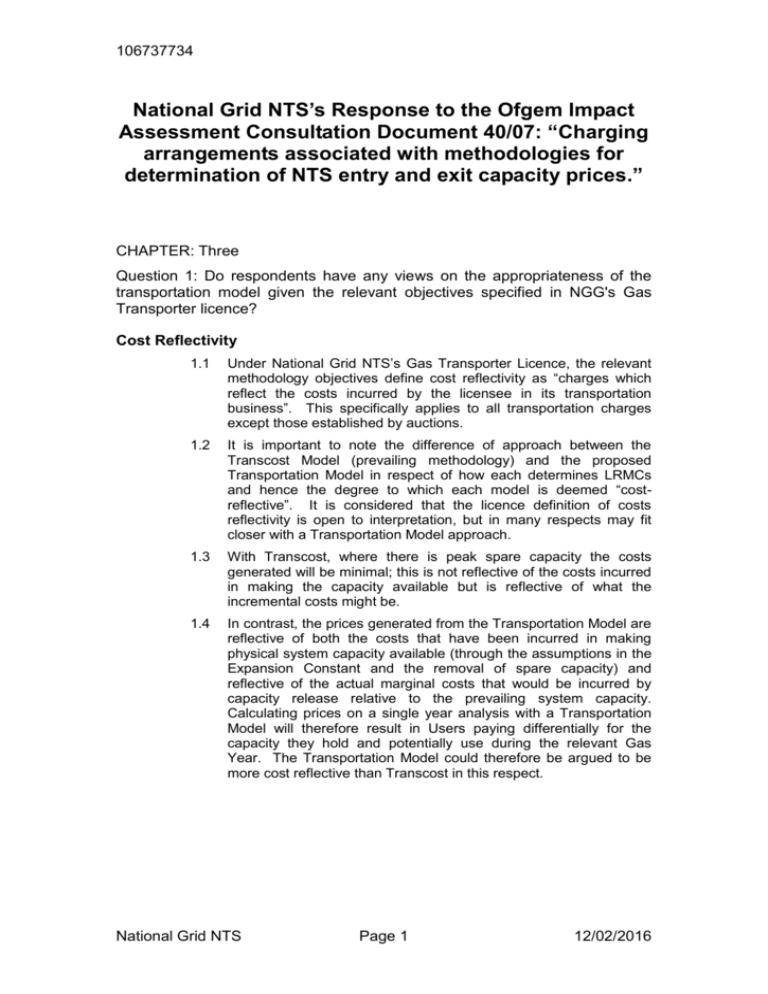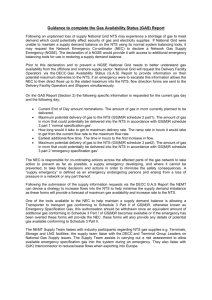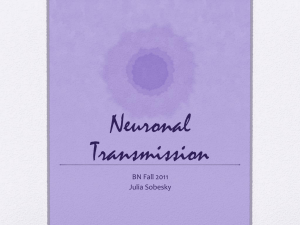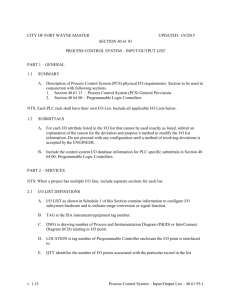national-grid-gas-v1-part-2
advertisement

106737734 National Grid NTS’s Response to the Ofgem Impact Assessment Consultation Document 40/07: “Charging arrangements associated with methodologies for determination of NTS entry and exit capacity prices.” CHAPTER: Three Question 1: Do respondents have any views on the appropriateness of the transportation model given the relevant objectives specified in NGG's Gas Transporter licence? Cost Reflectivity 1.1 Under National Grid NTS’s Gas Transporter Licence, the relevant methodology objectives define cost reflectivity as “charges which reflect the costs incurred by the licensee in its transportation business”. This specifically applies to all transportation charges except those established by auctions. 1.2 It is important to note the difference of approach between the Transcost Model (prevailing methodology) and the proposed Transportation Model in respect of how each determines LRMCs and hence the degree to which each model is deemed “costreflective”. It is considered that the licence definition of costs reflectivity is open to interpretation, but in many respects may fit closer with a Transportation Model approach. 1.3 With Transcost, where there is peak spare capacity the costs generated will be minimal; this is not reflective of the costs incurred in making the capacity available but is reflective of what the incremental costs might be. 1.4 In contrast, the prices generated from the Transportation Model are reflective of both the costs that have been incurred in making physical system capacity available (through the assumptions in the Expansion Constant and the removal of spare capacity) and reflective of the actual marginal costs that would be incurred by capacity release relative to the prevailing system capacity. Calculating prices on a single year analysis with a Transportation Model will therefore result in Users paying differentially for the capacity they hold and potentially use during the relevant Gas Year. The Transportation Model could therefore be argued to be more cost reflective than Transcost in this respect. National Grid NTS Page 1 12/02/2016 106737734 Exit Tariff Adjustment 1.5 It is National Grid NTS’s view that the objective of NTS Entry and Exit Capacity Prices is to provide price signals to Users in relation to the relative cost associated with providing capacity at different locations around the network. The advantage of the proposed Transportation Model tariff calculation approach, where exit prices are adjusted (additive) rather than scaled (multiplicative), is that it preserves the locational price differentials between Entry points and between Exit points and hence preserves the relative costreflectivity. Decoupling of Revenue Drivers 1.6 National Grid NTS’s view is that removing the link between UCAs for incremental revenue determination and NTS Entry Capacity Baseline Reserve Prices and setting prices using annually updated LRMCs, as defined within this proposal, would be more cost reflective than allowing reserve prices to continue to be set from revenue drivers, where those revenue drivers may not be updated over the formula period and may therefore become less cost reflective over time. Exit Rebalancing 1.7 Rebalancing of exit capacity tariffs to reflect changes in supply/demand and network configuration has not been undertaken since 2001. This was due to the desire to delay rebalancing on the expectation that NTS exit reform would be implemented in 2002. Subsequent delays to reform have led to a significant divergence in current tariffs and underlying LRMCs in certain locations. The benefit of updating exit capacity prices would be delivered under this proposal. Removal of Exit Price Capping 1.8 Prices are inherently driven by the supply & demand changes and hence subject to change year-on-year. The prevailing exit capacity price capping rules limit the year-on-year change and hence erode genuine cost reflectivity. The proposed Tariff model would increase cost reflectivity by removing year-on-year price capping. This can in part be justified by the move to a single year model as the price capping rules are mainly removing the impact of forecast error. Moving to a single year model also allows future years prices to be forecast from the ten year supply and demand forecast data hence mitigating the risk of price shocks. National Grid NTS Page 2 12/02/2016 106737734 Promoting Efficiency and Avoiding Undue Preference Single Year Model Price Signals 1.9 A single year model will allow National Grid NTS to generate both locational and temporal pricing signals to Users. For example, where a large new entry project is anticipated to come on stream, exit users will be able to determine when connection to the NTS in the same locality is most efficient in terms of capacity provision (as local exit prices will be predictable and likely to fall after the entry point first flows onto the NTS). National Grid can therefore avoid investment to continue to meet its security of supply obligations where users can make more informed choices regarding the timing of their connection to take advantage of lower prices in the future. This would not be the case for prices based on ten years of data. 1.10 In addition, a single year model will avoid the circularity caused by entry capacity auction prices being based on future network and supply/demand data which are, by their very nature, forecasts of auction outturns. Supply Data 1.11 All network analysis requires a balance between supply and demand and this is equally true of charging models. Under the prevailing Charging Methodology the supply forecasts are adjusted to obtain a supply and demand match given the 1-in-20 demand level. Some supply points will also not be forecast to flow at their Baseline level. This means that some Entry Points are not explicitly at their Baseline supply levels within the charging model. 1.12 This would be overcome under this proposal by carrying out Entry Point specific analysis for those Entry points that were not at their Baseline levels in the initial analysis and obtaining a supply and demand balance by supply substitution. 1.13 For example, where an Entry point was not at its Baseline level, or had been reduced due to a supply surplus, it could be adjusted to that baseline level with the entry point furthest from the entry point in question being adjusted in the opposite direction. 1.14 This approach ensures that all prices would be generated at a consistent supply level hence avoiding the undue preference that might be conferred by pricing some Entry Points based on reduced flows. Decoupling of Revenue Drivers: 1.15 The removal of the link between UCAs and prices would also ensure that the most economic and efficient locational signals for capacity between entry points are maintained over the course of the formula period. This would help users to make informed choices about where it is more efficient to signal their capacity requirement, in terms of the operation of the NTS. 1.16 Entry pricing based on the baseline/obligated level will ensure that prices reflect the requirement on National Grid to release up to the baseline level of capacity on each gas day, and also reduces the sensitivity of the prices to forecasts of supply flows. National Grid NTS Page 3 12/02/2016 106737734 Stability and Predictability 1.17 Prices are inherently driven by the supply and demand scenario and hence subject to change. Transcost was developed to replicate and simplify the decision making used in determining network investment with the engineering planning tool Falcon. Transcost was developed when flow patterns in the network were stable and when network load was forecast to grow steadily. At the time, due to the stable flow pattern, the choice of network configuration and compressor and regulator parameter setting within Transcost were simply based on the prevailing flow direction. By contrast, due to unstable and uncertain patterns of flow forecast in the near future, the choice of network configuration and compressor and regulator parameters is more time consuming and requires more sophisticated and arguably subjective network analysis. In particular, the choice of model parameters can influence the way that spare transmission capacity is generated for different flow scenarios. 1.18 At first sight, the Transportation Model might be perceived to be less cost reflective than a model which reflects the full physical realities of a gas transmission system. Replacing Transcost within the charging process with a Transportation Model removes the potential for subjectivity and sensitivity in the generation of capacity prices as the parameters that lead to instability (the choice of network configuration and compressor and regulator parameters) would no longer be modelled. Consistency 1.19 Implementation of this proposal from 1st October 2007 will ensure that all entry and exit NTS Capacity Prices are set on a consistent basis with prices being determined from a single transparent charging model. National Grid NTS Page 4 12/02/2016 106737734 Promoting Competition Transparency 1.20 It is National Grid NTS’s view that competition can be promoted in terms of the development of the Gas Transmission Transportation Charging Methodology by making it simple and easy to understand such that prices can be replicated and forecast by Users. While at first sight, the Transportation Model might be perceived to be less cost reflective than a model which reflects the full physical realities of gas transmission system, there are significant benefits in term of transparency and predictability. Using a single year’s forecast would allow the prices for the remaining years of the ten year plan to be forecast by both National Grid NTS and the wider industry. It is anticipated that this feature of the revised methodology would give greater confidence to users and reduce risk associated with price uncertainty hence promoting competition and reducing barriers to entry. National Grid believes the use of a single charging model (Transportation Model) will allow it to make more consistent estimates of LRMCs and therefore avoid undue preference in capacity pricing. The single charging model also allows both National Grid NTS and the users to easily make quick assessments of the value of capacity, therefore enabling the user to make informed decisions about purchasing capacity. 1.21 National Grid NTS continues to believe that the transportation model approach achieves the relevant charging licence objectives for the reasons stated in the NTS GCM 01 Consultation Conclusions document published 25th January 2007. Question 2: Do respondents wish to present any additional analysis that they consider would be relevant to assessing the proposal? 1.22 National Grid NTS do not wish to bring forward any additional analysis at this time. National Grid NTS Page 5 12/02/2016 106737734 Question 3: Do respondents consider that there are any aspects of the proposal that have not been fully assessed? 1.23 Extensive debate covering alternate approaches to NTS Capacity Charging has been carried out through the Gas Charging Methodology Forum between January 2006, when the topic was raised, and January 2007 when the GCM01 conclusions report was published. The development of capacity charging options is documented in the Gas TCMF progress report published 24th October 2006 and in the GCM01 reports. The Gas TCMF has also considered, over the last six months, options for NTS Exit Capacity Charging under exit reform including the potential use of the Transportation Model. This area of work was consulted on through discussion document NTS GCD 01 with the discussion conclusions report published 30th March 2007. As a consequence of these debates and consultations, NTS believe that all aspects of the proposal have been fully assessed. There are, however, related issues such as the formulation of Supply and Demand scenarios, information release and the impact of capacity charges on commodity charges, including revenue recovery and negative marginal costs, which National Grid NTS believe could be investigated by the Gas TCMF over the next year. Question 4: Do respondents have any specific views on the; (i) exclusion of spare capacity in the model; (ii) inclusion of backhaul into the model; and (iii) inclusion of only a single expansion factor into the model; and given these features of the proposed model whether the proposed model is an improvement compared with the current model (Transcost)? 1.24 National Grid NTS continues to believe that the transportation model approach represents an improvement on Transcost for the reasons stated in the NTS GCM 01 Consultation Conclusions document published 25th January 2007. The exclusion of spare capacity and inclusion of backhaul within the Transportation model result in charges that are reflective of expected usage of the system and would result in Users paying for the capacity that they utilise. National Grid NTS Page 6 12/02/2016 106737734 Treatment of Spare Transmission Capacity 1.25 Prices generated from the Transcost model are in theory more reflective of the incremental investment costs that will be incurred when compared with the Transportation model approach. It can, however, be seen that route costs are not necessarily allocated appropriately to entry or exit. This results in Users paying for capacity on the basis of capacity that happens to be available in the local vicinity; the more capacity there is, the lower the price. When peak spare capacity is present, this may result in Users not paying for the capacity they utilise and recovering the costs associated with this capacity via other charges will therefore lead to cross subsidies. 1.26 If a single year is modelled with Transcost, and therefore without taking out spare transmission capacity, the resulting charges are volatile and will not, over a period of time, be reflective of costs incurred in adding capacity. Costs may be minimal when there is spare capacity and at an annuitised LRMC when there is congestion, which over time would not cover the cost of the investment. Generating prices from a ten year model might reduce the volatility but would mean that prices were reflective of the average cost over the ten year period rather than a specific year. This would be inconsistent with the period when exit capacity is being procured and the period for which entry capacity is procured in the medium and short term auctions. 1.27 In contrast, the prices generated from the Transportation Model are reflective of both the costs that have been incurred in making physical system capacity available (through the assumptions in the Expansion Constant and the removal of spare capacity) and reflective of the actual marginal costs that would be incurred by capacity release relative to the prevailing system capacity. Calculating prices on a single year analysis with a Transportation Model will therefore result in Users paying differentially for the capacity they hold and potentially use during the relevant Gas Year. The Transportation Model could therefore be argued to be more cost reflective than Transcost in this respect. 1.28 Spare capacity has been a key issue in developing and assessing charging options, however the final option proposed to the Authority and supported through industry responses, does not model spare capacity. The transparency, stability and predictability of the Transportation model approach are largely a function of not modelling spare capacity. Removing spare capacity also ensures that prices are reflective of actual costs incurred which would not otherwise be the case. The one benefit that can be obtained from modelling spare capacity is that prices might incentivise the use of such spare capacity however it is recognised that this is only possible through creating cross subsidies. Through considering the responses to this consultation National Grid NTS has come to the view that offshore costs and offshore and NTS capacity availability along with wholesale gas prices will influence where gas is landed more than NTS entry prices and hence the benefits of excluding spare capacity from the charging model outweigh any lack of incentive to use spare capacity. National Grid NTS Page 7 12/02/2016 106737734 Backhaul Benefit 1.29 A key benefit of this proposal is that the Transportation Model is more easily able to accommodate the beneficial effects of counterflows than the prevailing Transcost approach due to the fact that it does not include spare capacity. This effects the prices set for northerly exit points in particular as explained below. 1.30 In the prevailing Charging Methodology, the Excel Solver is used to generate Entry and Exit prices from a route cost matrix produced by Transcost. The solver iteratively calculates a set of entry and exit prices which minimises the difference between the entry plus exit prices and the route costs estimated by Transcost. 1.31 Through analysis presented at the Gas TCMF, National Grid NTS has demonstrated that entry plus exit costs can only exactly match the route costs when a model does not include spare transmission capacity but does include a backhaul benefit equal to the avoided cost of investment1. It is the presence of spare peak transmission capacity and the lack of a backhaul benefit inherent in the Transcost approach combined with the latest supply and demand scenario that produces the counter intuitive allocation of costs to northern exit points and southern entry points demonstrated via the Gas TCMF analysis2. A number of Tariff model changes were investigated to attempt to remove these pricing distortions but none were successful. Single Expansion Factor 1.32 Through the gas TCMF process a number of alternate approaches to calculating NTS capacity prices were investigated including two variants of Transportation Model. The first used a single expansion constant and the second used pipe diameter specific expansion constants. 1.33 The Transportation Model that used a single expansion constant resulted in the most stable year-on-year prices. The pipe diameter specific approach conceptually might be anticipated to be the most cost reflective however this approach will predict incremental costs based on the existing pipeline diameter which does not represent the fact that more recently National Grid NTS has been using 9001200mm pipelines for reinforcement. This can be seen in the Milford Haven results where single factor model is closest to the prevailing UCA which was based on the planned 1200mm expansion whereas the results from the multi-factor model result in a much higher price due to the prevalence of 600mm pipe in South Wales. 1 Gas TCMF Analysis Report October 2006– Section 5 2 Gas TCMF Analysis Report October 2006– Section 7 National Grid NTS Page 8 12/02/2016 106737734 1.34 The single expansion factor therefore allows prices not to be influenced by accidents of history i.e. which pipe diameters were used in the past, and allows for a single model for determination of all Entry and Exit i.e. prevailing/baseline and incremental, as costs are based on what we would build not what we might have built in the past. CHAPTER: Four Question 1: Do respondents have any views on the additional analysis set out in this chapter? 1.35 National Grid NTS welcomes the additional analysis carried out by Ofgem and believe that it reinforces the argument that the charging methodology defines the distribution of revenue collected and not the level. Changes in exit charges are driven by updating the network model and supply and demand data with exit charges not having been rebalanced for the last five years. While Entry capacity charges might increase as a consequence of removing spare capacity this will only result in lower TO commodity charges. Question 2: Do respondents wish to present any additional analysis that they consider would be relevant to assessing the proposal? 1.36 National Grid NTS do not wish to bring forward any additional analysis at this time. CHAPTER: Five Question 1: Do respondents consider that we have appropriately outlined the key environmental impacts of the proposal? 1.37 National Grid NTS agree that, as this proposed modification is to substitute the Transcost model in the methodology with the Transportation Model, there is no direct environmental impact arising from the modification proposal. 1.38 It is the inclusion of backhaul combined with the removal of spare capacity within the Transportation model that will provide stronger locational signals to large exit users, such as power stations, to locate closer to NTS entry points. National grid NTS agrees that this could have an impact on a small number of new gas fired generators deciding to locate closer to NTS entry points and so reducing the need for NTS reinforcements should they have located further from the entry point. National Grid NTS Page 9 12/02/2016 106737734 Question 2: Do respondents consider that there are other environmental impacts that should have been assessed? 1.39 National Grid NTS has not identified any other environmental impacts that should have been assessed. Question 3: Do respondents have any additional analysis in relation to environmental impacts that they wish to present? 1.40 National Grid NTS do not wish to bring forward any additional analysis at this time. CHAPTER: Six Question 1: Do respondents have any views on both the process and timetable that are proposed for taking forward this assessment of the modification proposal? 1.41 National Grid NTS notes that should the GCM01 charging modification proposal not be vetoed there will be sufficient time to give the required notice of revised entry charges ahead of the annual QSEC auctions in September 2007 and revised exit charges ahead of the 1st October 2007 implementation 1.42 National Grid NTS notes that should the GCM01 charging modification proposal be vetoed there is unlikely to be sufficient time to develop and consult on any alternate NTS capacity charging proposal ahead of the annual QSEC auctions in September 2007. National Grid NTS Page 10 12/02/2016






